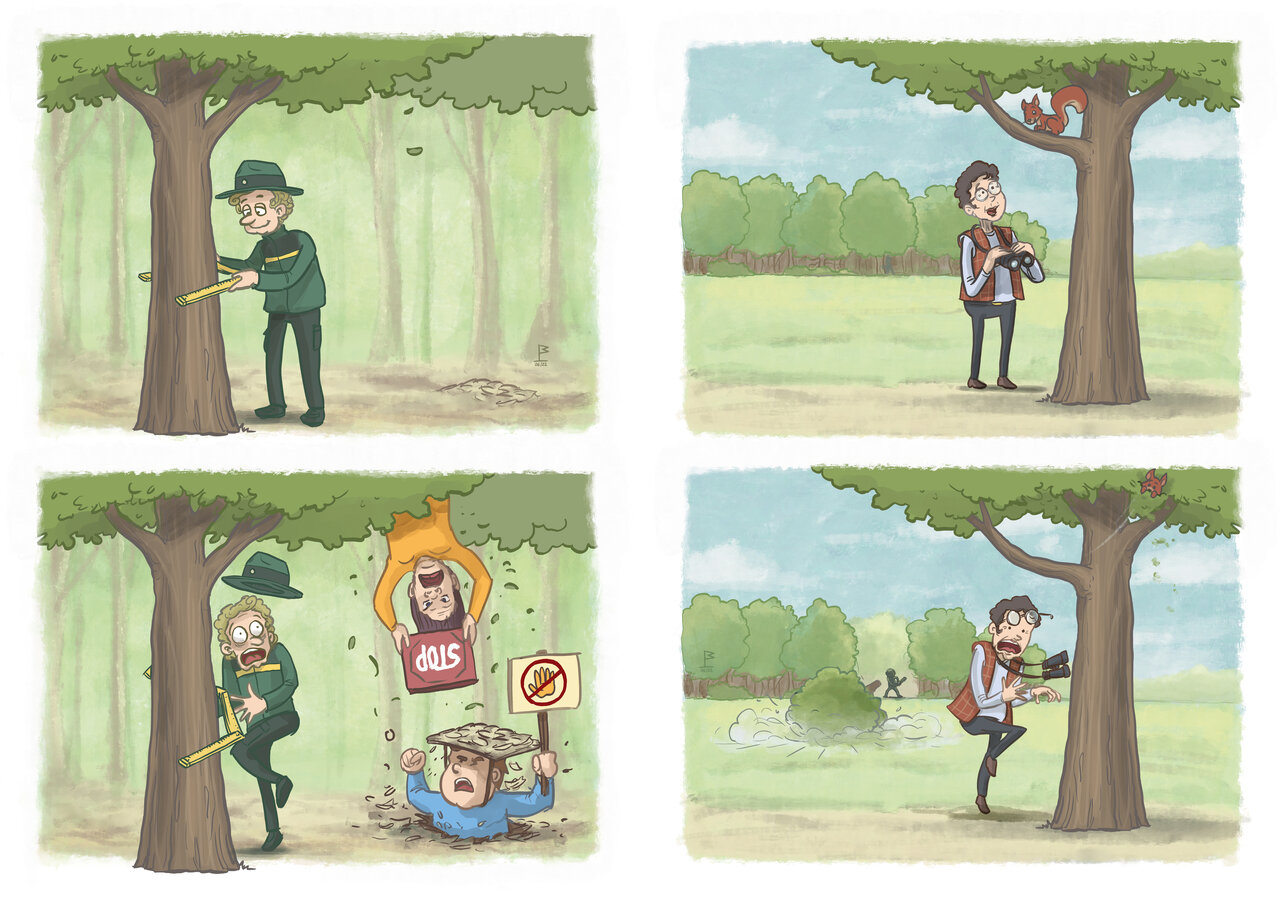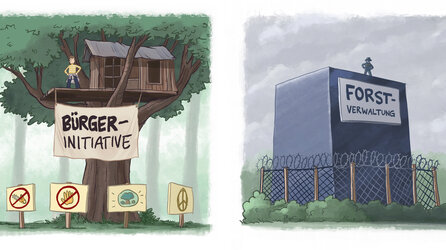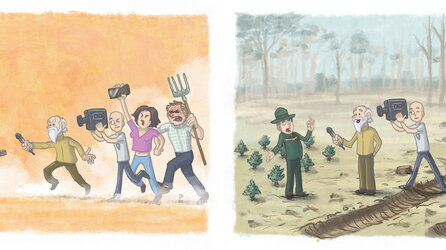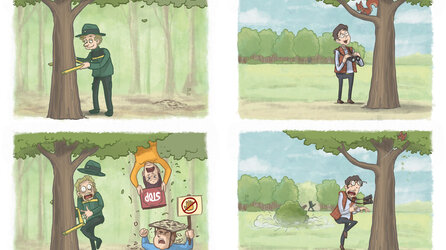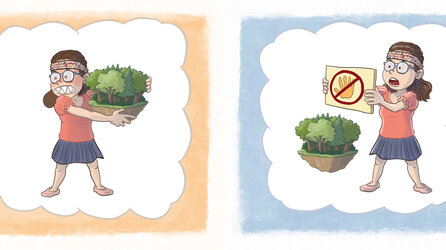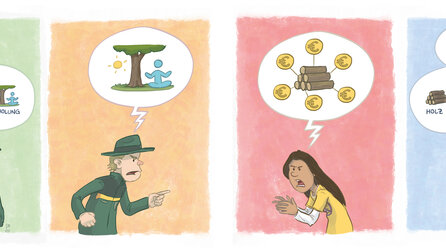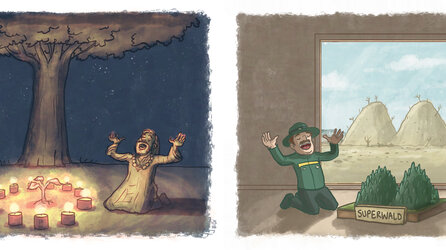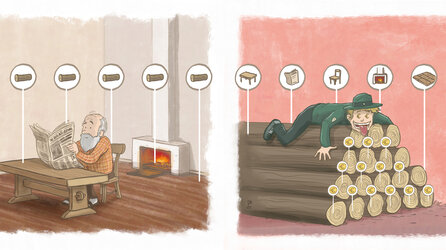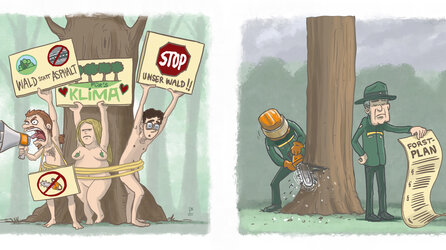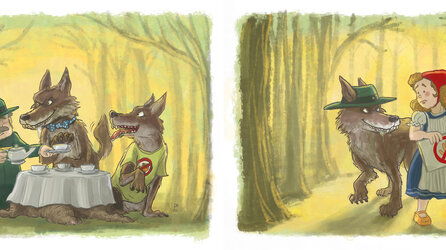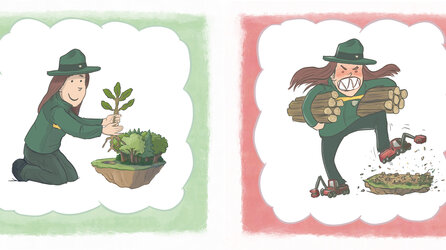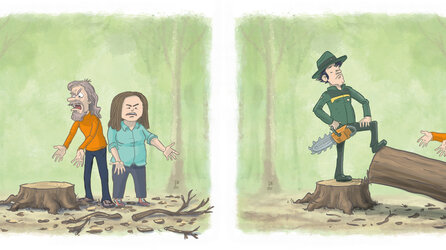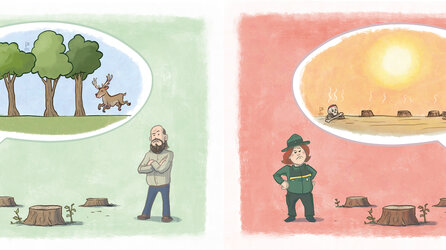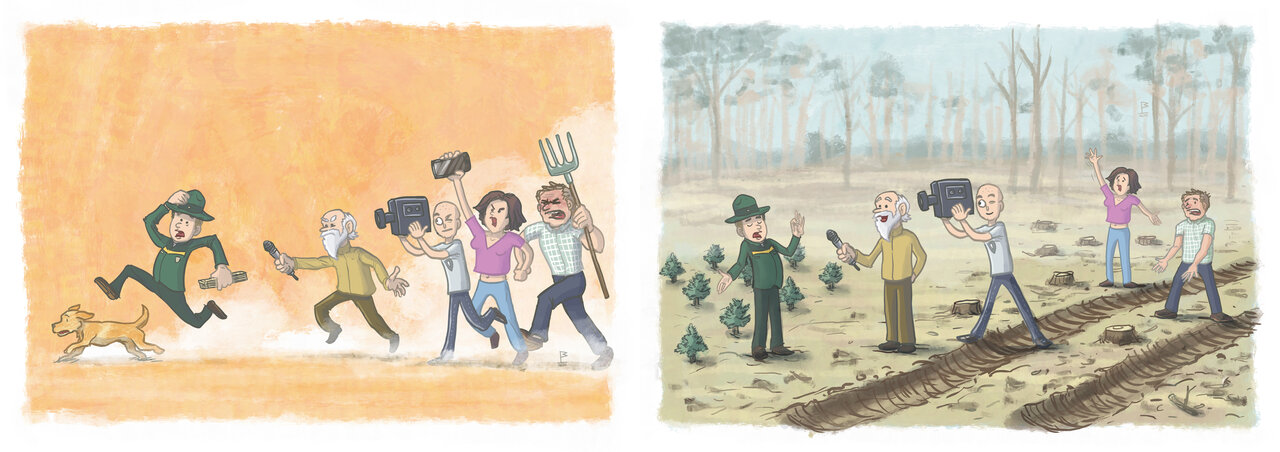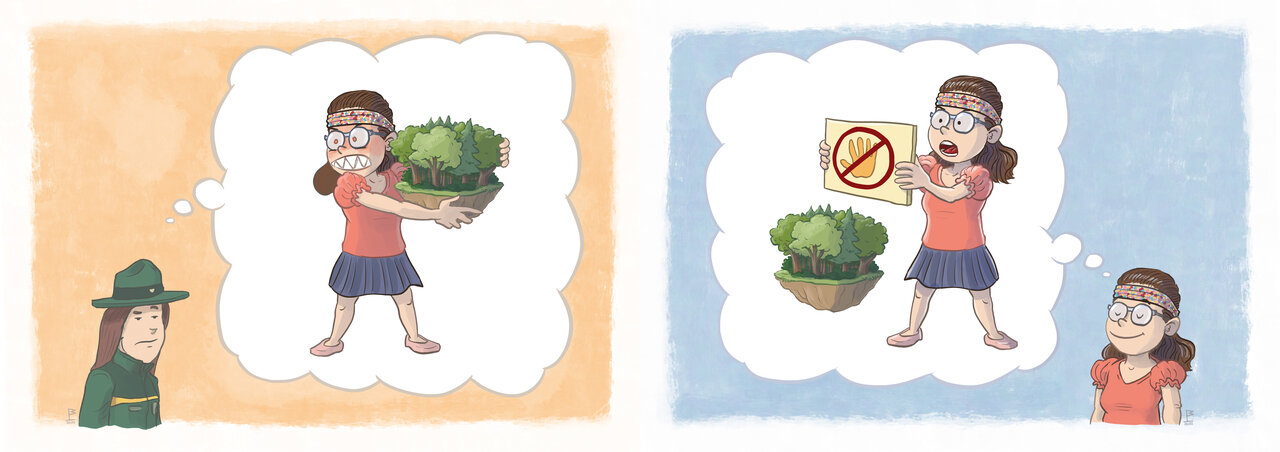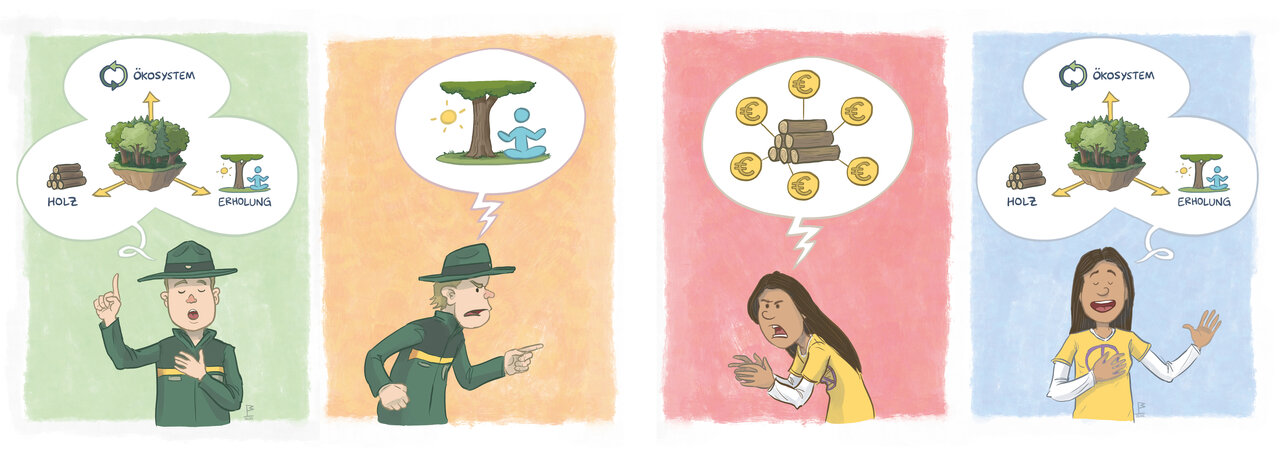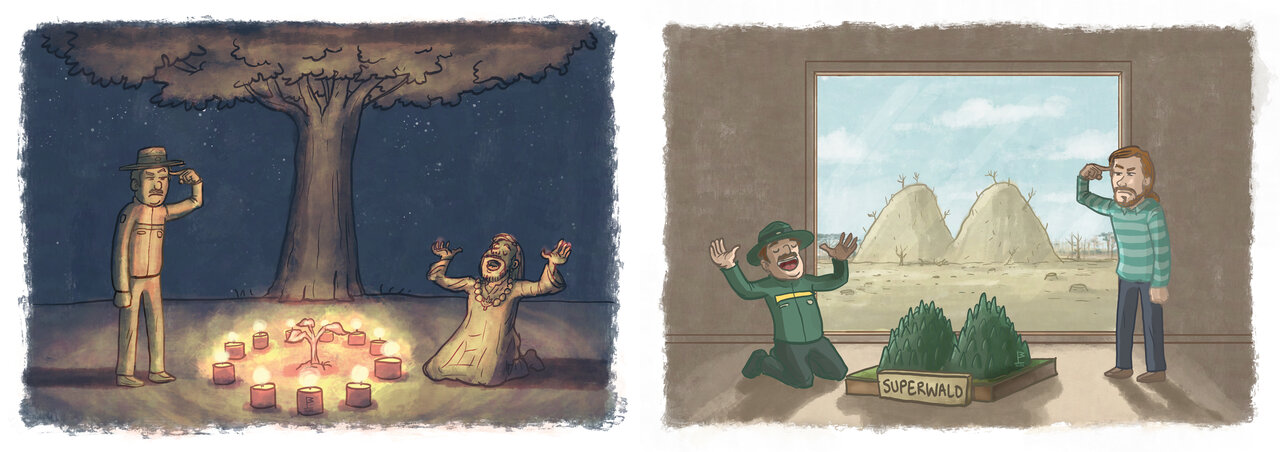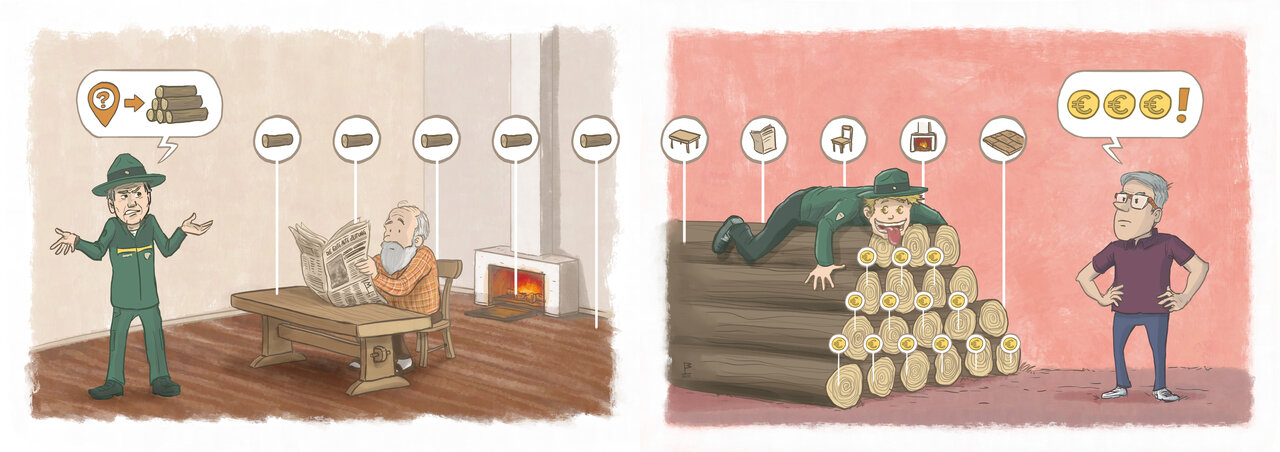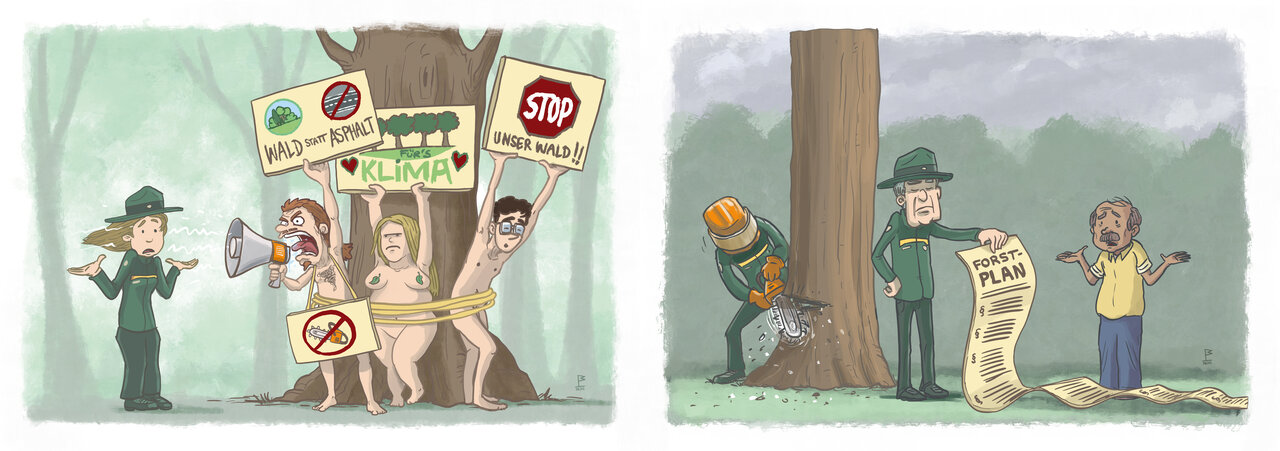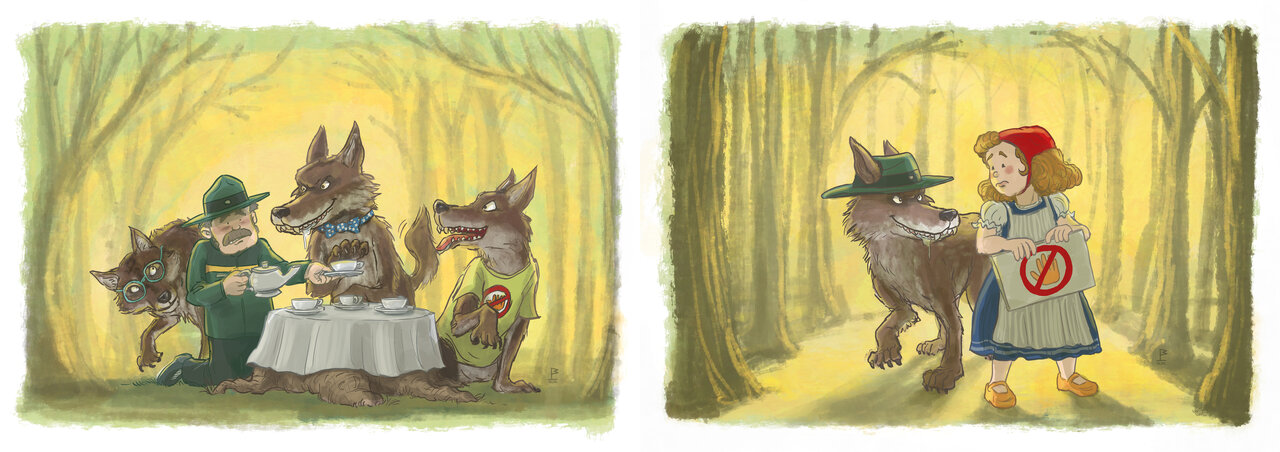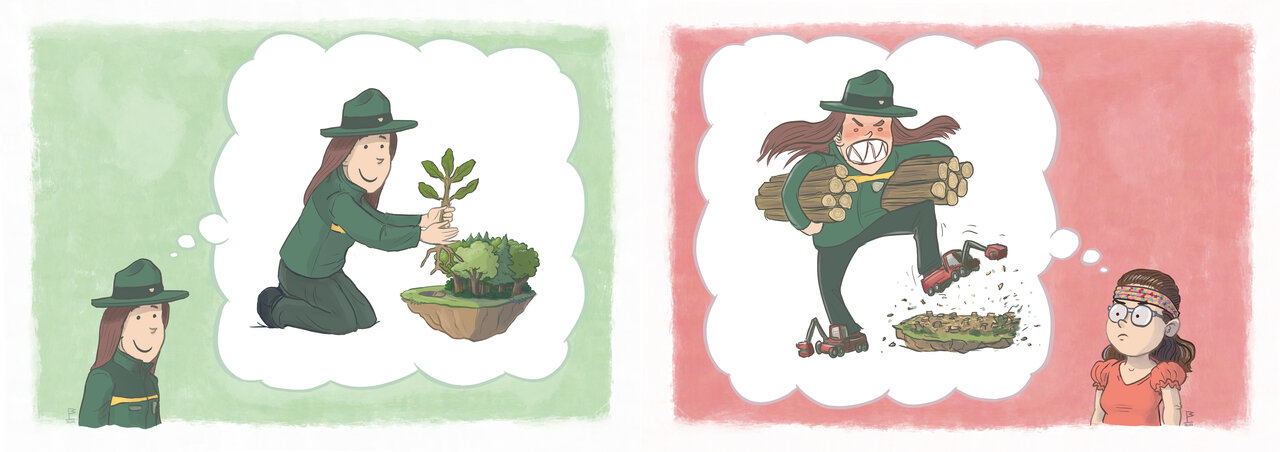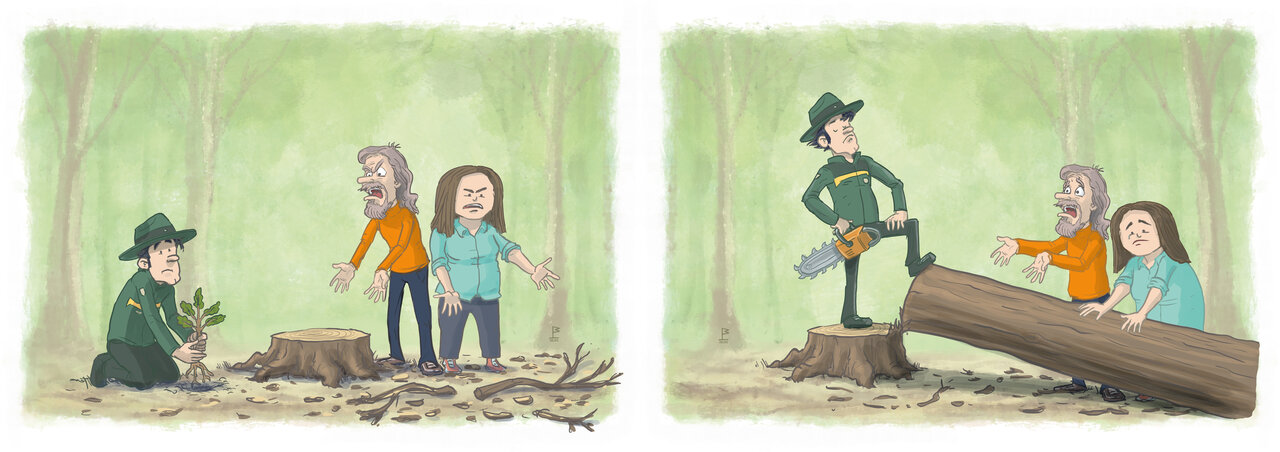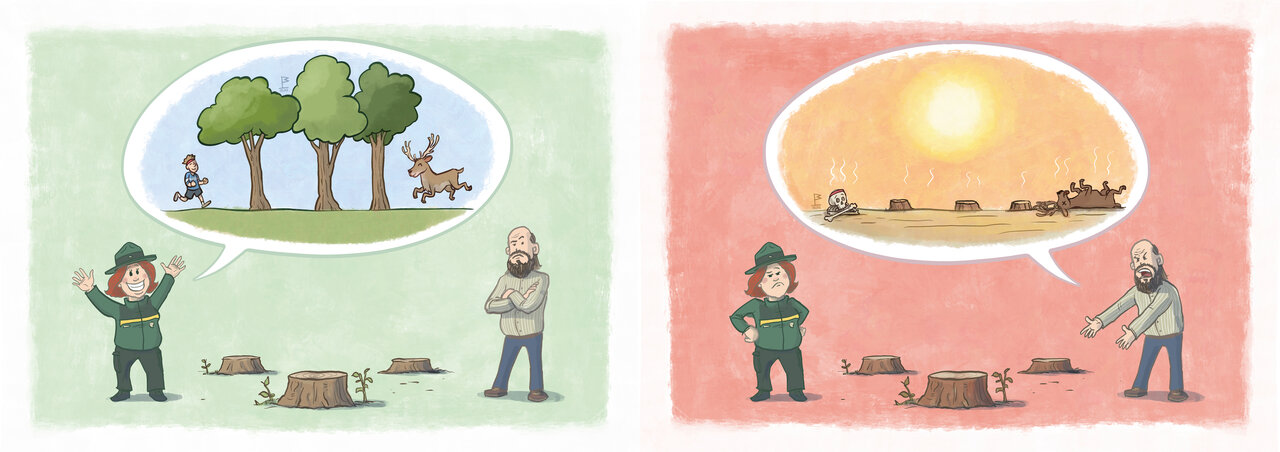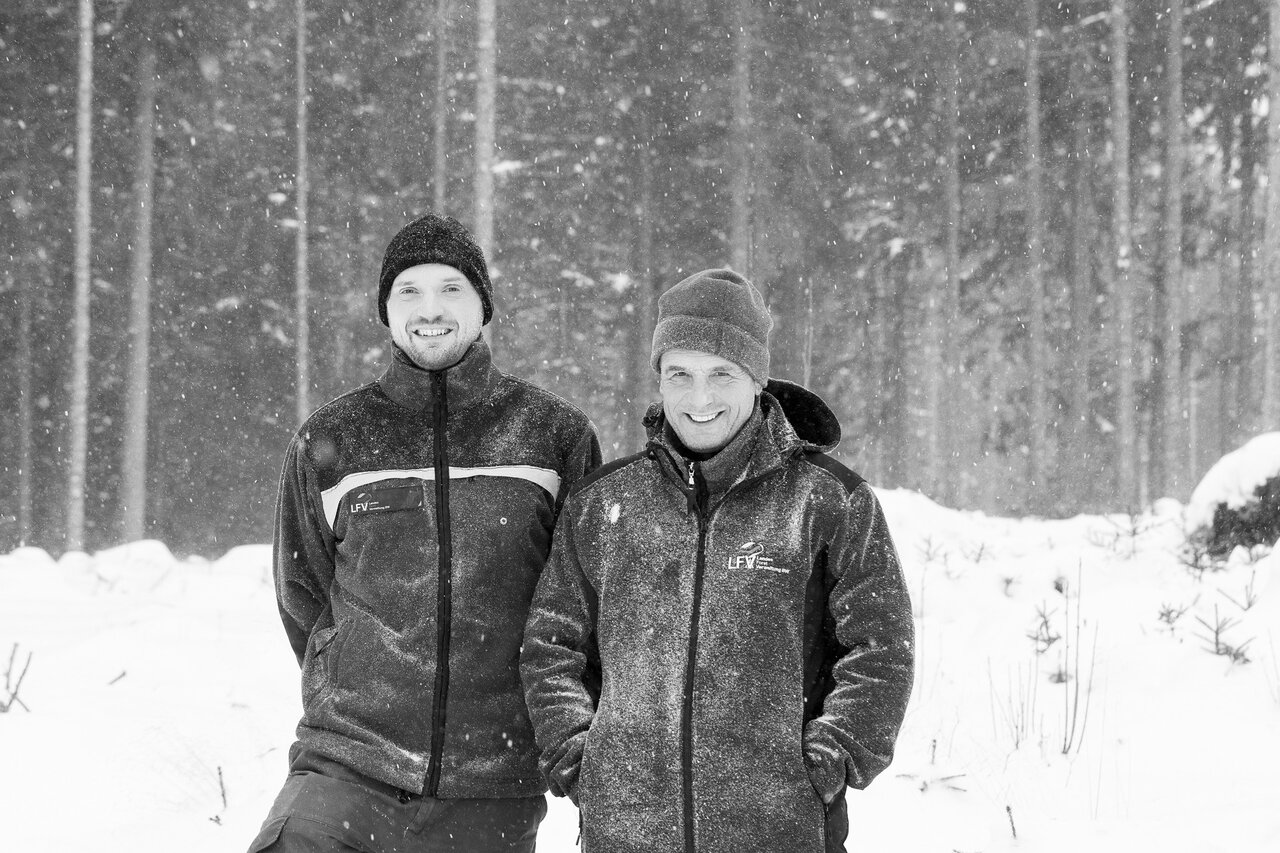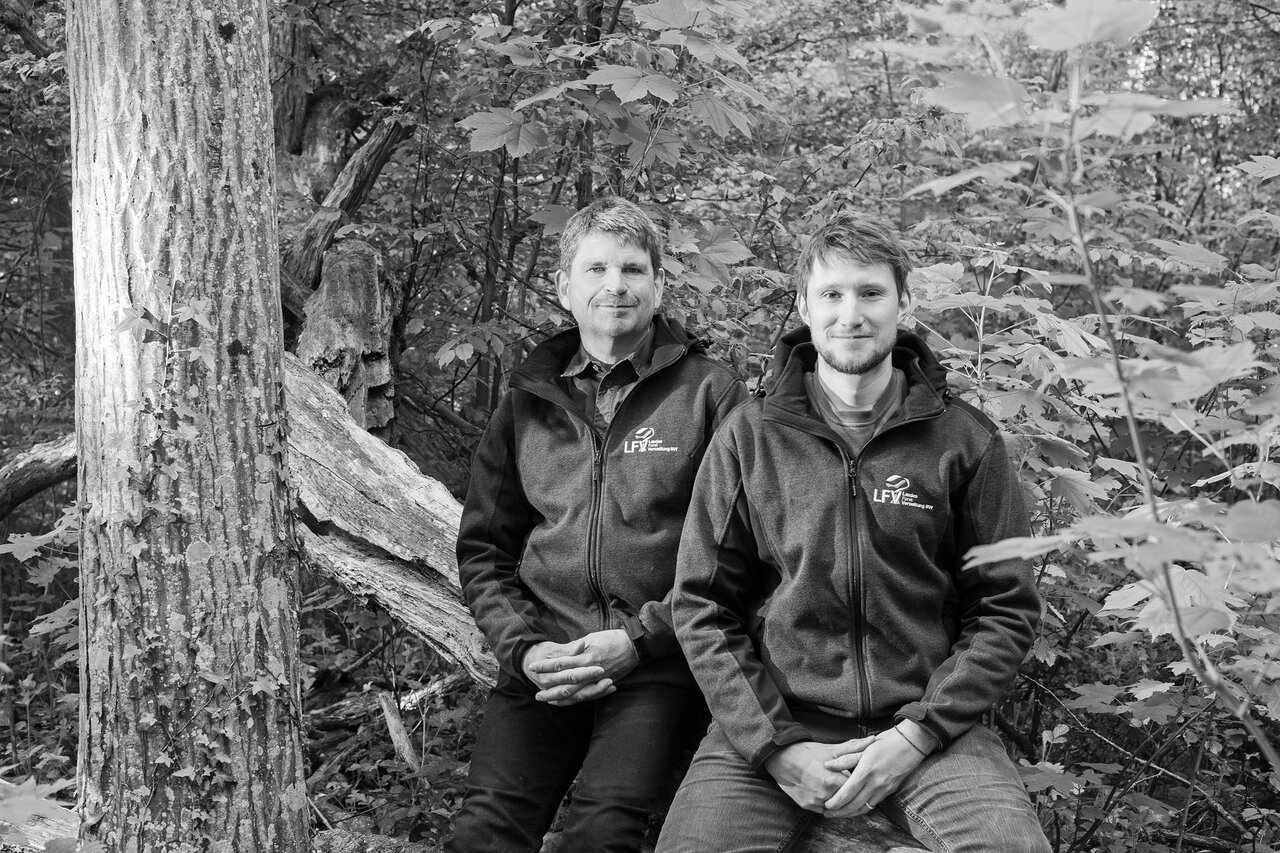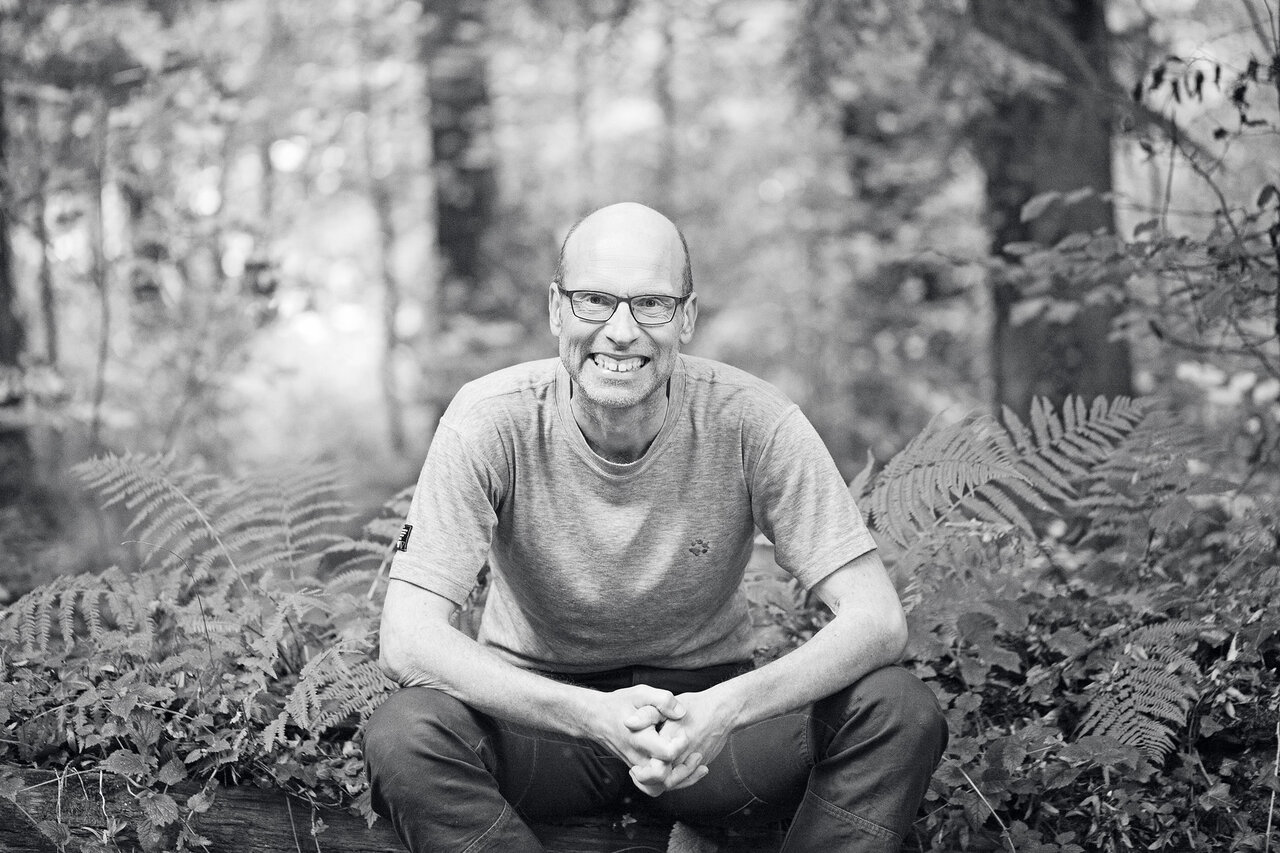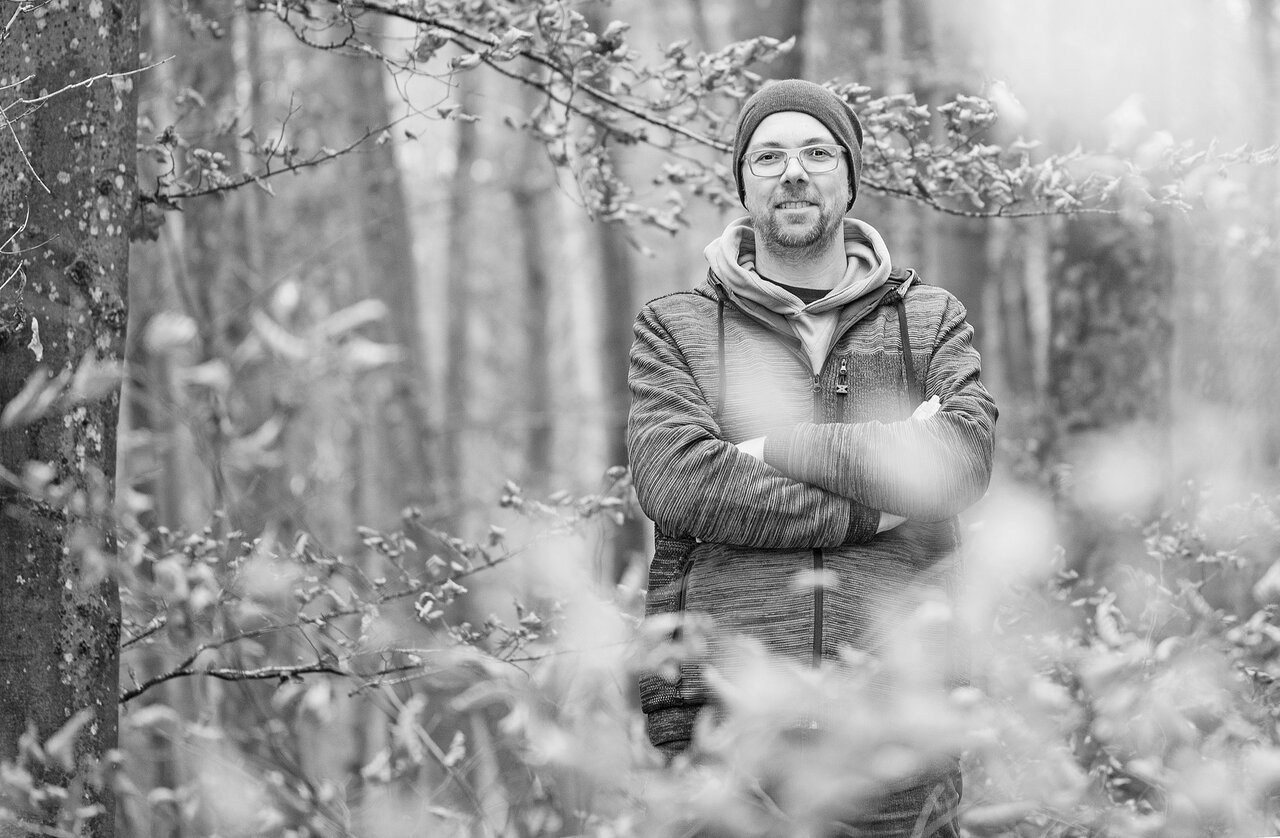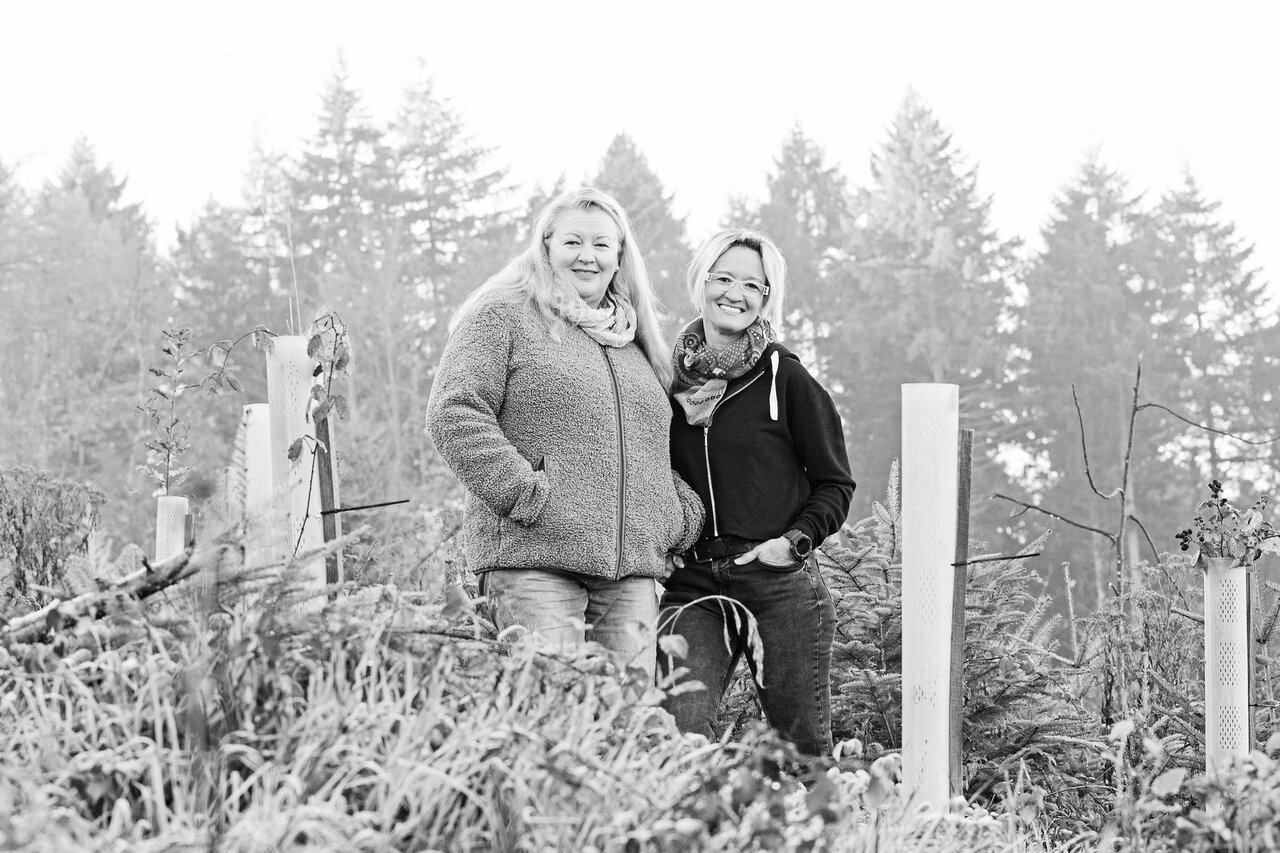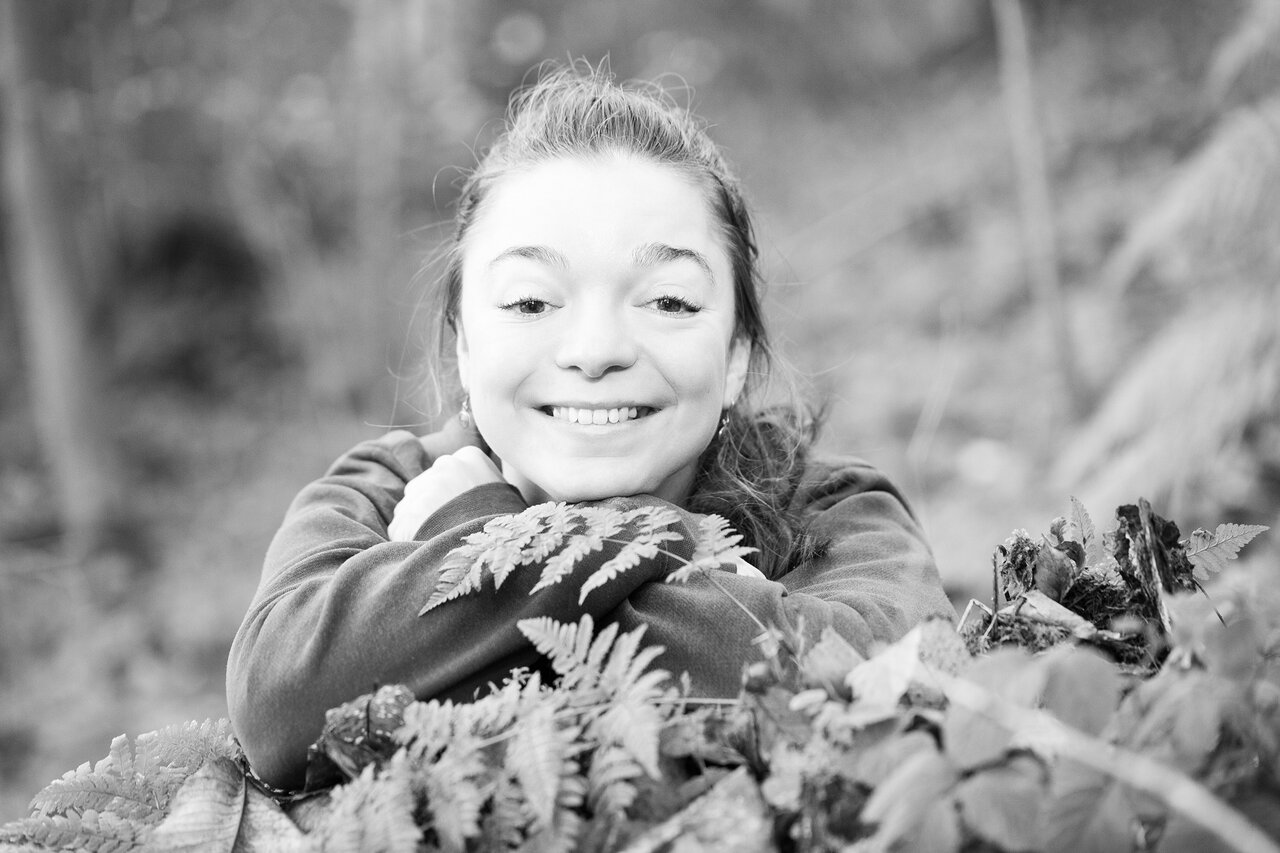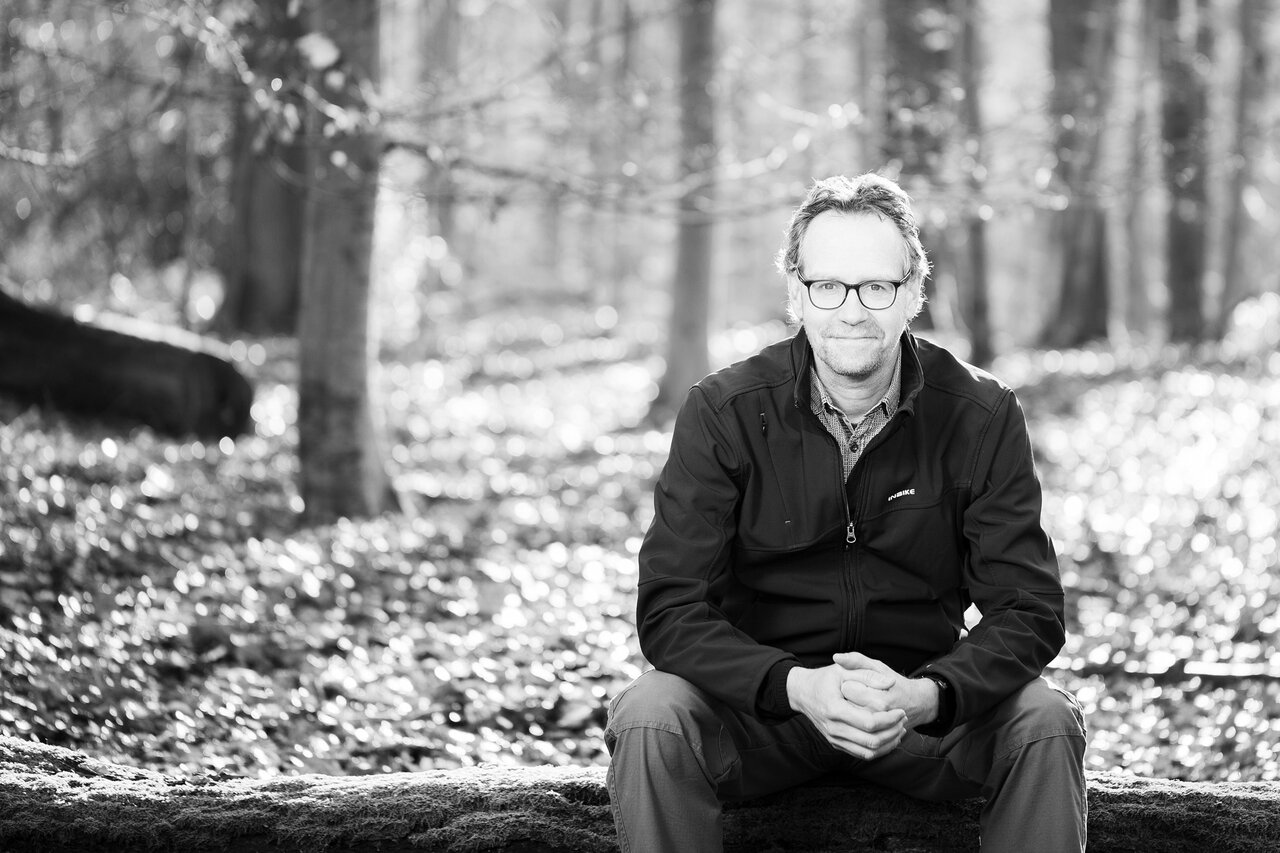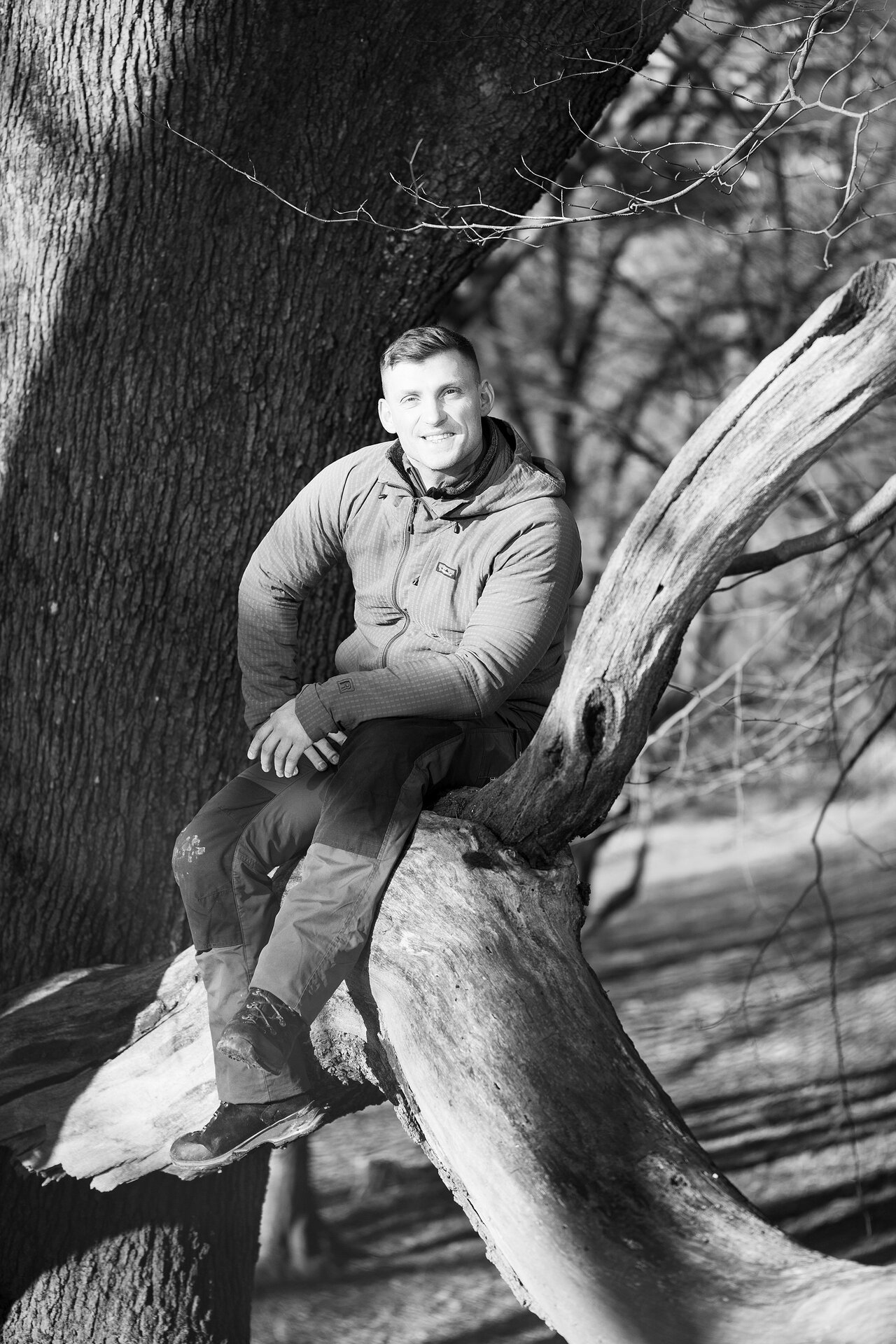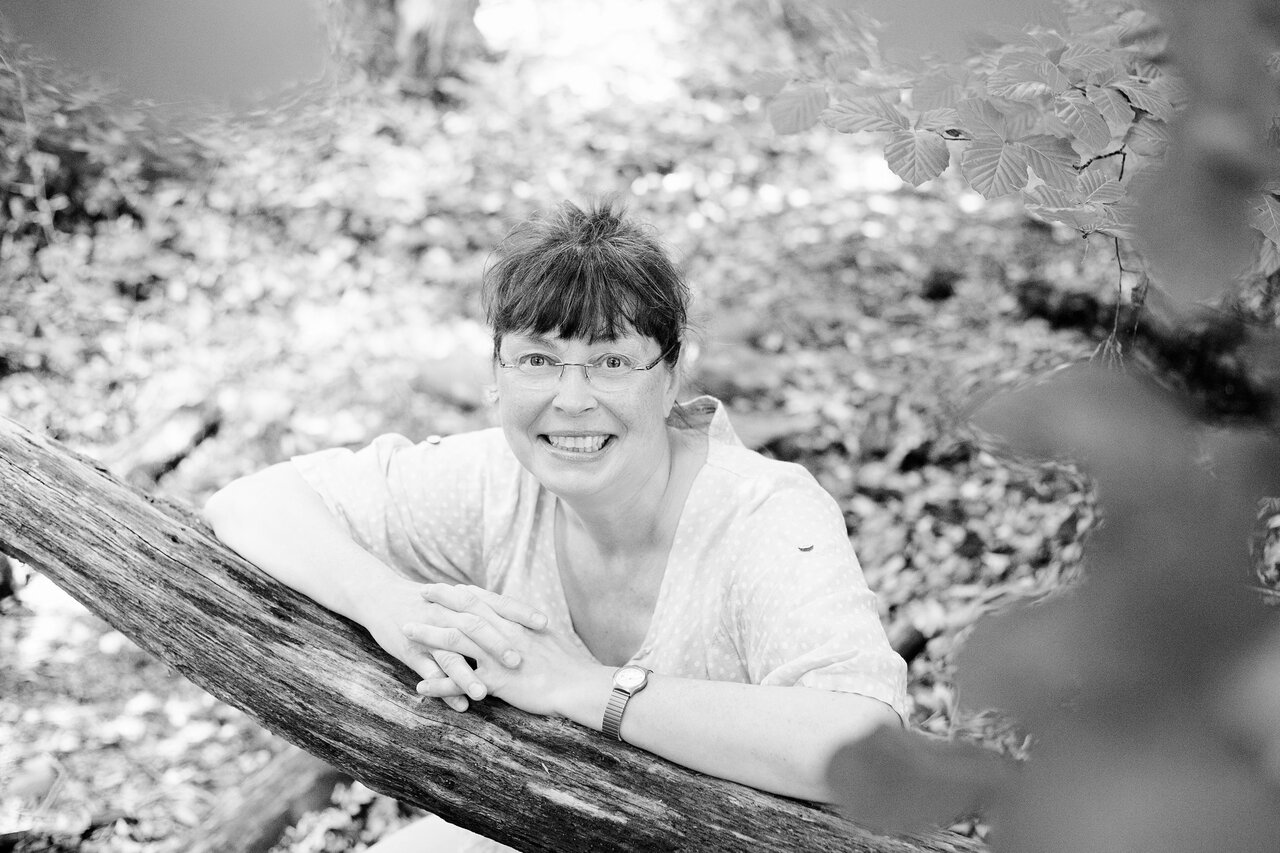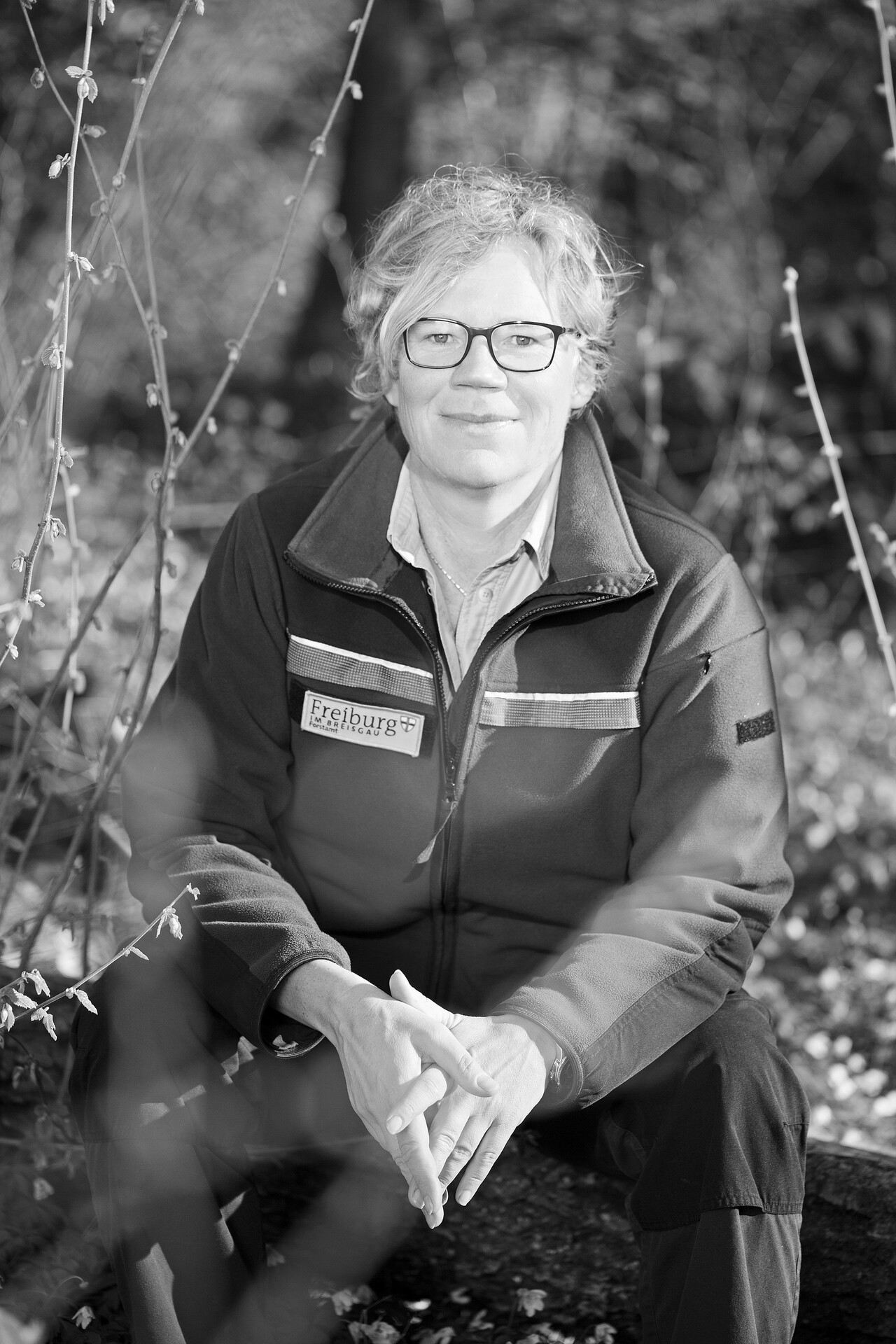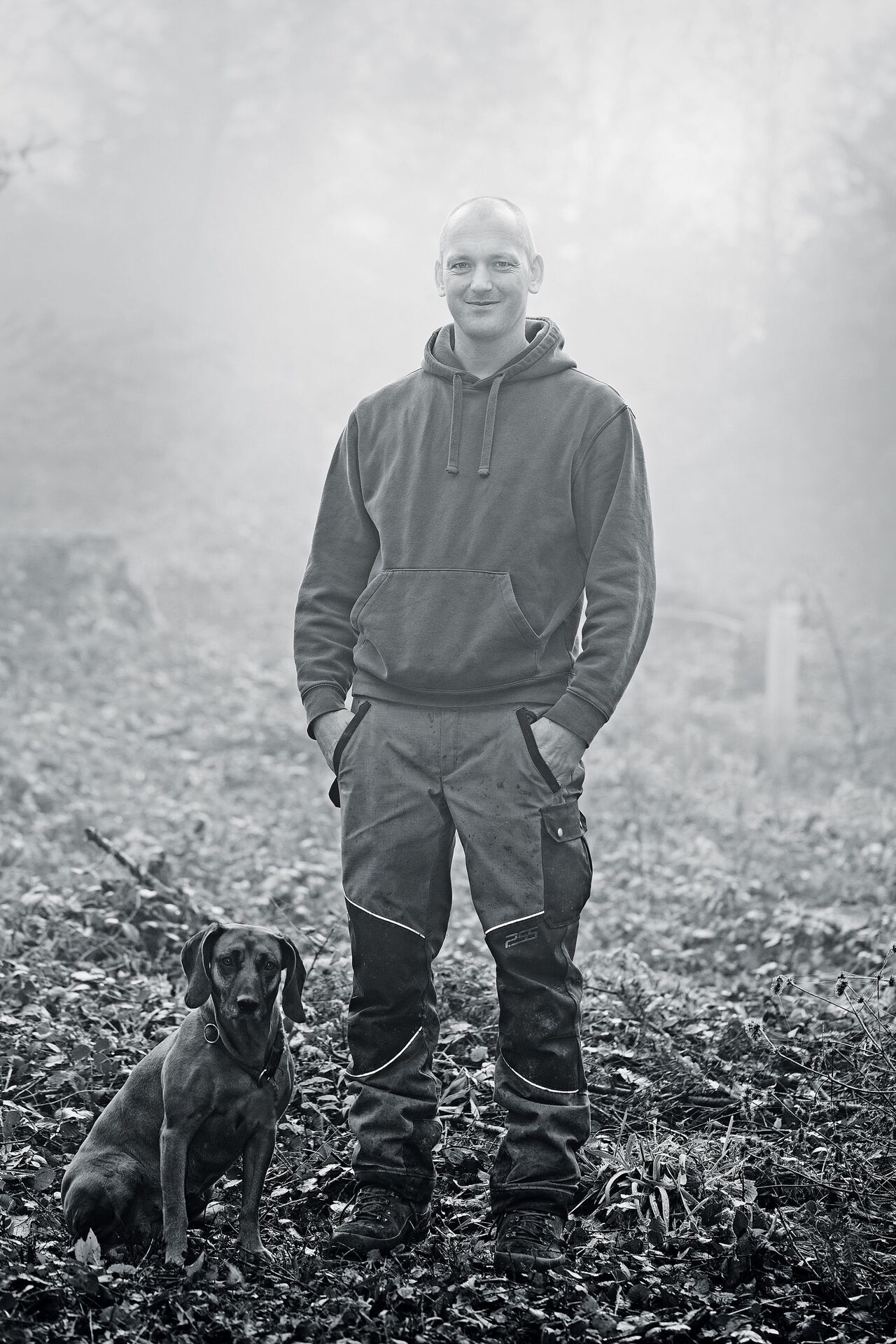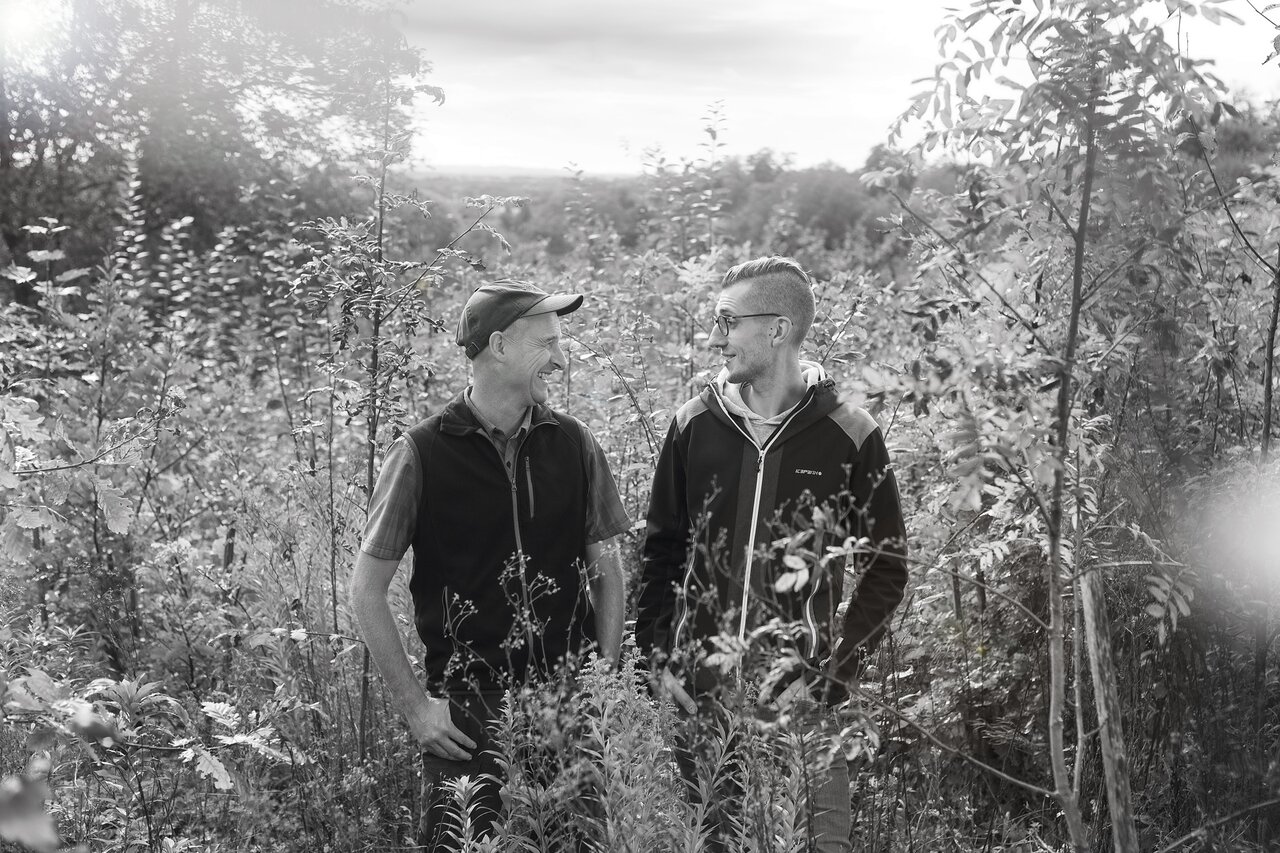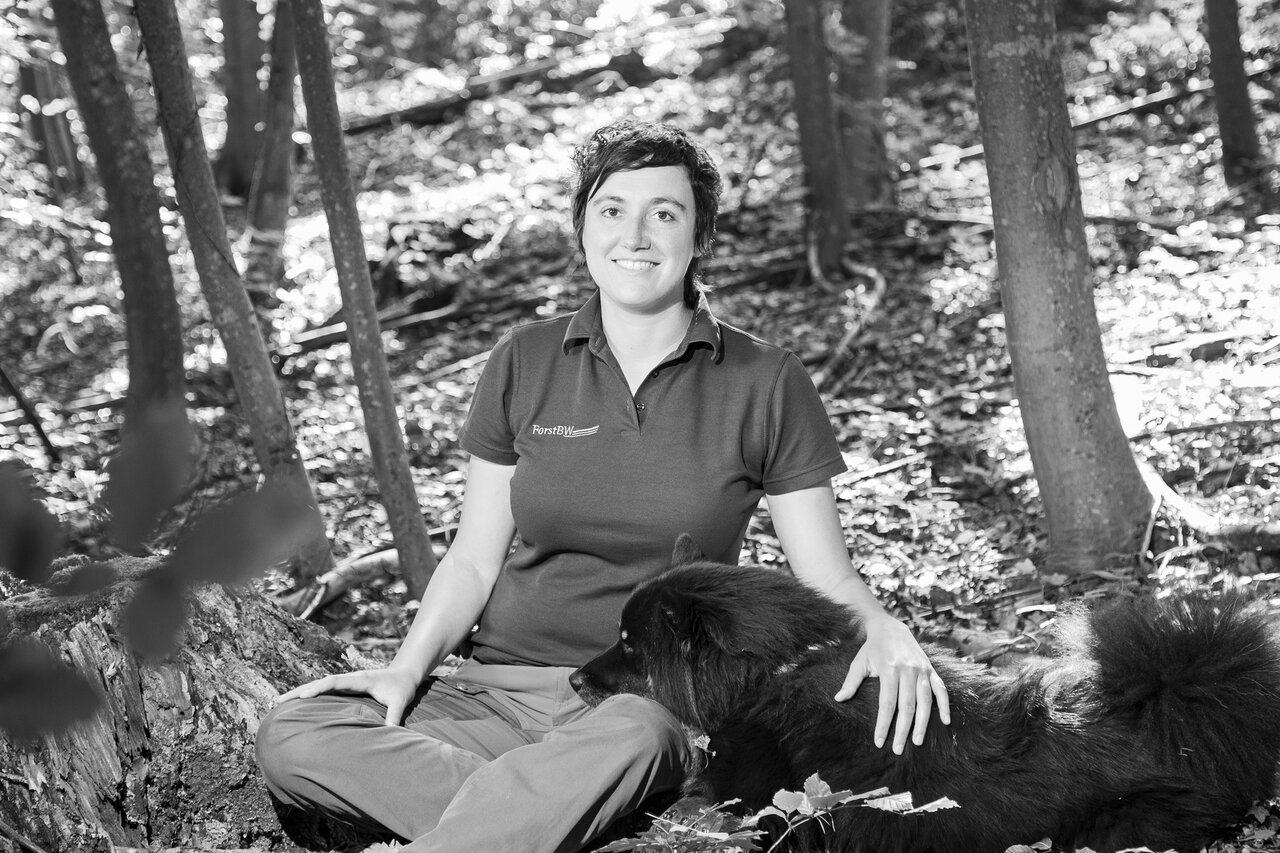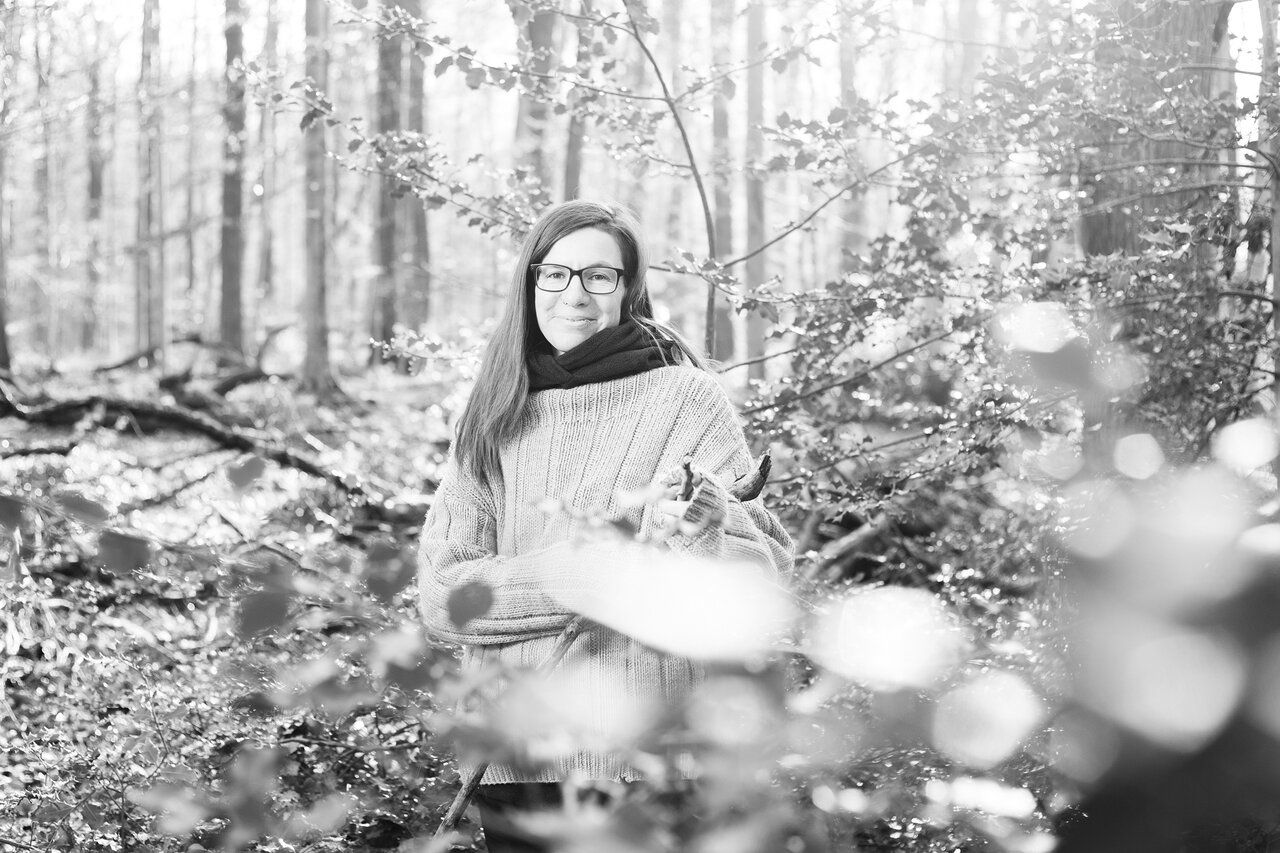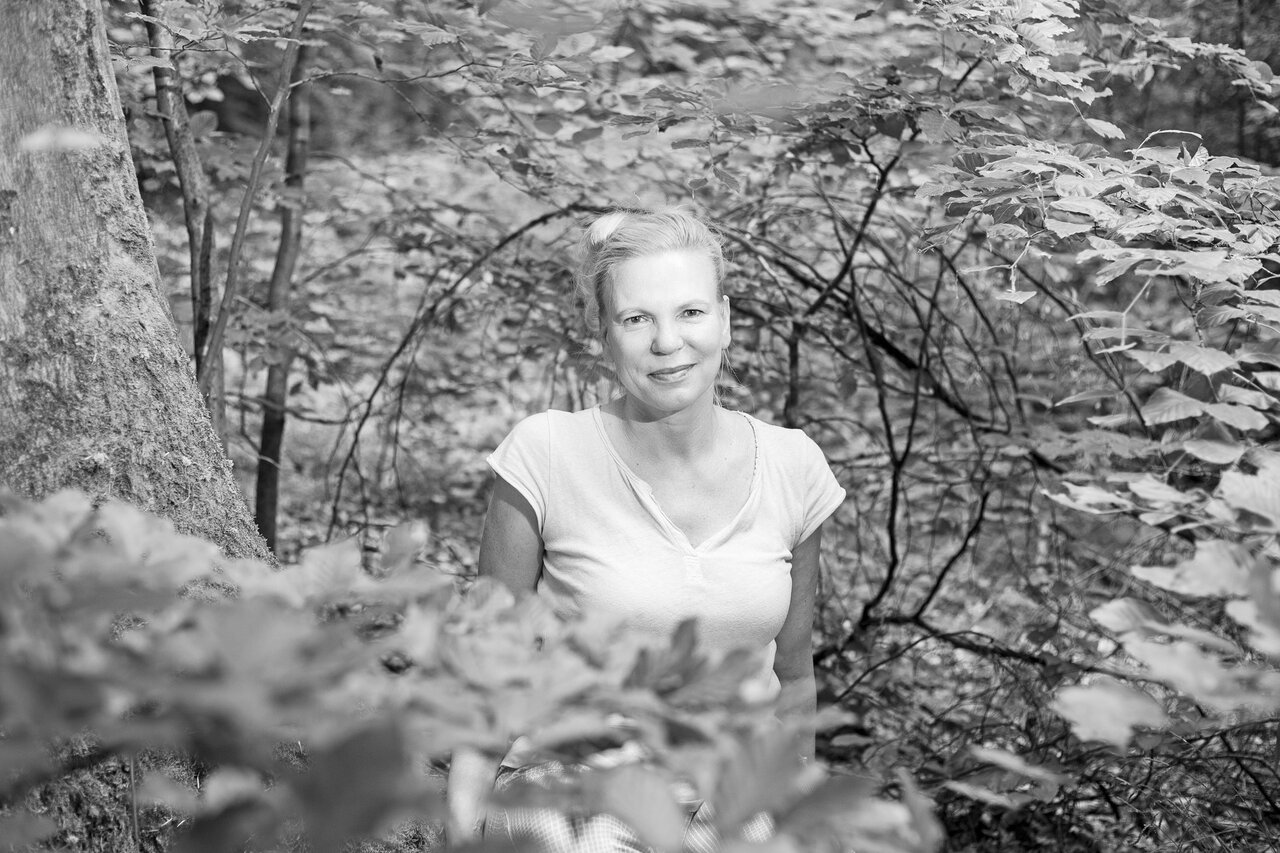Every truth has two sides – also in the forest
Foundations for a constructive dialog concerning forest related conflicts
The current debate about the future of our forests is all over the media. At the same time, conflicts between citizens and foresters are on the rise. The needs, interests, values and worldviews of those involved in the conflicts differ significantly. For a successful and constructive dialogue, it is important to understand these and thus develop a certain understanding for each other. Unfortunately, mutual mistrust, a lack of appreciation, and a lack of understanding of each other’s perspectives often complicate constructive exchanges between those involved.
This is the challenge that the project ‘Every truth has two sides – also in the forest!’ is addressing. Various media (caricatures, an animated film and portraits) have been developed together with foresters and people involved in citizens’ initiatives. The media should encourage a change of perspective, help to reflect on your own point of view with a smile, and promote mutual understanding. In this way, they are intended to support both those citizens committed to the cause and foresters, as well as other conflict participants, in promoting and establishing appreciative communication and a constructive dialogue.
Below you will find the media that have been created, background information on their development and information on how to use and borrow them. We hope you enjoy discovering and, of course, have constructive discussions – for lots of forest fun instead of forest frustration!
Background
The conflicts between citizens and foresters revolve primarily around questions of the ‘right’ approach to our forests: How should these be protected and managed in order to preserve them for people and nature in the future? What measures make sense and which do not? And how can the many different interests regarding the forest be reconciled? These are just a few of the substantive issues shaping the conflicts over our forests.
However, it is not only questions of substance that are the cause of such conflicts. On the contrary, it is evident that many of those involved in citizens’ initiatives have often lost confidence in foresters and the administrative institutions behind them. At the same time, the conflicts repeatedly come as a surprise to the foresters involved. They often feel that their forestry competence and their efforts on behalf of the forest are disrespected. For these reasons among others, the parties to the conflict are unable to reach an understanding for a long time in many places, and instead the conflict is becoming increasingly entrenched.
Media development through participation and involvement
The project ‘Every truth has two sides – also in the forest’ follows on from the project ‘Sociocultural forest monitoring’ which produced a brochure entitled ‘Der Streit um den Wald’ (‘The Fight Over the Forest’, 14MB in German). At the beginning, results from this predecessor project were analysed more specifically considering current developments. Based on this, a participatory process was designed in which both foresters (a total of 15 people) and people involved in citizens’ initiatives (a total of twelve people) contributed their perspectives in workshops. Two separate workshops were held for each of the two ‘groups’. In each of these, participants initially developed six messages that they would like to pass on to the ‘other side’ and which most accurately portrayed forest-related conflicts from the participants’ point of view. A media designer then developed the first sketches for cartoons based on these messages. These were then further developed by the workshop participants, together with the messages, in the second workshops. The main question here was whether the cartoons and messages were understandable and could be accepted by the participants.
In addition to the workshops, the project was supported by an advisory board consisting of experts and representatives from forestry, forest ownership, forest-related citizens’ initiatives, nature conservation communication, public relations and mediation. They helped shape the project’s orientation and advised on possible networking and the nationwide benefits of the project.
The outcome of this participation process consists of the messages and cartoons developed together in the workshops, portraits of foresters and people involved in citizens’ initiatives and initiatives for active reforestation (in German), as well as an animated explanatory film.
At this point, we would like to thank all participants in the participatory process and all those who were willing to be portrayed for our project. Without them and you, this project and these results would not have been possible!
The media building blocks
Naturally the full range of forest-related conflicts cannot be represented in such a project. Especially since not only citizens’ initiatives and foresters are involved in these conflicts, but many other institutions and people (e.g. municipalities as forest owners or nature conservation administrations). Therefore, the presented media can only provide insight into the views and perspectives that the project participants consider most important and relevant to them. In this way, the exhibition is primarily intended to support the concerns and interests of those who are ostensibly involved in the conflicts, who have to deal with each other and who are often seen by the public as the ‘face’ of the conflicts. These are mainly foresters and the members of forest-related citizens’ initiatives.
Nevertheless, we want to make visible as many of the perspectives as possible on how we deal with our forests and the wide range of commitment to the forest, whether private or professional. All those involved in the conflict and other people who are also committed to the forest (e.g. those who were willing to be photographed in the context of their ‘commitment to active reforestation’ for this project) have one great thing in common: enthusiasm for the forest, which must be shared (in a constructive dialogue)!
We hope that this exhibition will contribute to a constructive dialogue. These are creative, artistic products and ‘people talk about art’, as we all know.
We would therefore be delighted if you too would like to use the media created for your interests! The media can and should be used widely – for example, for information stands, conflict discussions, mediations, various participation formats or simply to engage in informal and constructive dialogue or to reflect on your own views.
You will find the resulting media below. They are available free of charge for non-commercial purposes under two conditions:
- The source as well as media author (cartoons and film: © Michael Tewiele, photographs: © Wiebke Hebermehl) must always be mentioned.
- The cartoons must never be shown in isolation, but always presented with both perspectives. After all, a one-sided representation could fuel conflict. That is not in the interests of the project and all those involved!
If you need cartoons or images in a higher resolution, feel free to contact us.
Cartoons
Here you can see all the cartoons in an overview. All cartoons are shown again below with the accompanying messages.
Thoughts from foresters:
‘We do our work to the best of our knowledge and belief. That’s why a forest occupation can really derail us.’
Thoughts from citizens’ initiatives:
‘We want transparent communication at eye level and comprehensive information on forest condition, forest management and timber sales in a timely manner. We are hopeful that honest interaction with each other will lead to a consensus in the future.’
Thoughts from foresters:
‘The ongoing discussions on climate change are putting the forest into the focus of public attention and reporting. We often feel hounded by the media. We would like to also report on other things in the forest.’
Thoughts from citizens’ initiatives:
‘We have the impression that we, as citizens’ initiatives, are often shunned by the media and, above all, that reporting is carried out from the forestry perspective. We would like to see public media outlets reporting on the arguments of citizens’ initiatives and foresters on an equal footing.’
Thoughts from foresters:
‘We feel responsible for the forest and do our best. That’s why we don’t always understand the criticism and protests, for us they usually come out of nowhere.’
Thoughts from citizens’ initiatives:
‘The forest is the basis of all our lives. That is why it is our wish, our right and our duty to get involved with the forest. Time and again, we get the feeling that the use of wood is the top priority. We would like to see greater attention paid to ecology and recreation.’
Thoughts from foresters:
‘We often don’t understand what is supposed to be wrong with our work. Involvement with the forest is welcome; we want to work together for the forest of the future. But we want our work to be valued.’
Thoughts from citizens’ initiatives:
‘We are concerned that “our” forest will be severely damaged if we do not stand up for it. We want our cause to be taken seriously and our involvement to be valued, even if we are “only” citizens.’
Thoughts from foresters:
‘Forests are ecosystems, timber producers and places of recreation. In the current situation, however, we sometimes get the impression that forests are only seen as a place of recreation. We are also afraid of losing credibility and feel that our competences are being denied.’
Thoughts from citizens’ initiatives:
‘Forests are ecosystems, timber producers and places of recreation. We understand that. In the current situation, we fear damage to the ecosystem and loss of social benefits. This is why we want a fundamental shift in the way we deal with wood.’
Thoughts from foresters:
‘We feel respect for nature, which is another reason why it is important to us to preserve the forest. At the moment, the forest needs our support. This is why we must and want to actively shape the forest of the future.’
Thoughts from citizens’ initiatives:
‘We are afraid that our basis of life will be destroyed, threatening our livelihoods and those of our children. We would like to see greater respect for nature and appreciation of forests as a whole. For the forest of the future, we want forest management that takes greater account of forest nature.’
Thoughts from foresters:
‘We all need a lot of things made out of wood every day. One of our tasks is to provide this timber from native forests – for all of us! We would sometimes like to see more recognition for this.’
Thoughts from citizens’ initiatives:
‘Of course we need wood and we do not reject wood use on principle. But using wood is just one important task that forests fulfil. We want to be more economical with wood and want less wood to be burned.’
Thoughts from foresters:
‘We want what’s best for the forest, that’s our job. Like many people, we just want to do our jobs. The current forest conflicts are a great challenge for us, which we do not want to avoid. We often don’t understand the reason for the conflict. That’s why we’d like to talk to you to understand you better.’
Thoughts from citizens’ initiatives:
‘Forests are our basis of life and we must preserve them for future generations. Of course it makes sense to plan forestry measures in the longer term, but it also has to be possible to adapt plans to current developments, such as climate change. Why is that not possible? What are you really about?’
Thoughts from foresters:
‘Sometimes we feel quite cornered by the criticism of our work and at the mercy of our critics. Let’s find a common place to share everything: The forest is a place to talk, because the forest is famous for its relaxing effects.’
Thoughts from citizens’ initiatives:
‘We often feel that we and our concerns are not taken seriously by foresters. That is why we are worried about being “taken to the cleaners” in talks. We would like to see a dialogue between equals and appreciation and recognition of the professional skills we have acquired.’
Thoughts from foresters:
‘Our main concern is to maintain and conserve the forest. At the same time, there are many demands on forests that we must and want to meet. The demands of the citizens’ initiatives are only part of this. It’s not that easy to always meet all needs.’
Thoughts from citizens’ initiatives:
‘The forest is our basis of life. We are committed to it because we are afraid for its existence. The way the forest often looks after forestry measures and how the soil is destroyed by large equipment hurts us.’
Thoughts from foresters:
‘We love our profession and want the best for the forest. The criticism of our work hits us hard, especially when only accusations are made. We would like to have a factual discussion.’
Thoughts from citizens’ initiatives:
‘Often we feel we’re being looked down on ‘from above’ by the forest services and not taken seriously, although we also have experts in our ranks. It annoys us when dialogue as equals is not possible.’
Thoughts from foresters:
‘In these difficult times, it is particularly important to preserve the forest for future generations. That is why we must act now and set the direction. That’s our job!’
Thoughts from citizens’ initiatives:
‘If we want to preserve the forest in times of climate change, less is more. We fear that what you call “forest management” will lead to “forest loss”.’
Film
Portraits
Martin Bach, District Forester Feldberg and Jens Göttfert, Forest Nature Conservation Centre, Southern Black Forest
Jens Göttfert, Forest Nature Conservation Centre, Southern Black Forest
‘It is important to me to show that forestry and nature conservation are not mutually exclusive. This can best be achieved through joint action. While we were once tending a capercaillie habitat together on the site, a capercaillie came along and looked at what we were doing. This allowed the volunteers to observe directly what they were working for. Such encounters are something very special!’
Martin Bach, District Forester Feldberg
‘I am a “woodsman”, as they say, a Black Forest woodsman. The forest is my lifeblood and home. I’m in it every day, I live for it! I see us humans as part of nature. We have to learn to deal with it in a way that works for us, but also works for the whole. That’s the art, that’s what I'm trying to do.’
Jürgen Bucher and Fabian Wangler, District Forester Schönberg
Jürgen Bucher, District Forester Schönberg
‘The forest is my profession... but also my passion because I love this natural space. I’m fascinated by old, natural forests. I always rejoice when there are still big, old trees. Yes, that is actually what I want to leave to future generations and what I want to contribute to. This is also why we are planting young forests so that future generations will be able to find large, old trees again.’
Fabian Wangler, District Forester Schönberg
‘There are places in our forest where you feel like you’re in a jungle ... And when you see something like that, I always love it.’
Frank Borsch, Civic Engagement
Frank Borsch, Civic Engagement
‘The forest is a place of rest for me. The forest means to be away from everyday stress. The forest means hiking, mountain biking, trails, and more. The forest is home. I hope that in a hundred years there will still be at least as many forests in Germany as there are today.’
Jens Eber, Citizen Engagement in Active Reforestation
Jens Eber, Citizen Engagement in Active Reforestation (Bürgerschaftliches Engagement in der aktiven Wiederbewaldung)
‘It is increasingly common to hear that forests have been damaged by climate change. People who value, like or love the forest are likely to develop a sensitivity to this and think about what they can do for the forest.’
Annette Eilers and Christina Kiefer, Corporate Engagement in Active Reforestation
Alicia Fischer, Citizen Engagement in Active Reforestation
Hubert Kohler, Citizens’ Initiative ‘Rettet den Eichwald’ (Müllheim)
Hubert Kohler, Citizens’ Initiative ‘Rettet den Eichwald’ (‘Save the Oak Forest’) (Müllheim)
‘The forest I am committed to is home to over 200-year-old oaks. I have respect for those trees. These trees tell a story. They’re home to bats and all sorts of insects. Such a forest is rarely found anymore, such a forest needs special care!’
Gottlieb Müller, Citizen Engagement in Active Reforestation
Gottlieb Müller, Citizen Engagement in Active Reforestation (Bürgerschaftliches Engagement in der aktiven Wiederbewaldung)
‘I am committed to the Black Forest because it has been so present all my life and gives me a sense of home, connection and security. In line with the sustainability mantra – ‘think globally, act locally’ – my commitment to this forest is my small contribution to sustainable social transformation. On a small scale, everyone can contribute.’
Birgit Riedel, Action Alliance Save the Mühltal Forest) (Heidelberg)
Birgit Riedel, Aktionsbündnis Rettet den Mühltalwald (Action Alliance Save the Mühltal Forest) (Heidelberg)
‘The forest is a wonderful refuge. I feel like a guest in the forest in this wonderful world, and have respect and reverence for the life of the forest and the life in the forest. I want the forest to be preserved and to remain healthy or to be restored to health, to become closer and closer to nature and for timber to be harvested with sensitivity.’
Nicole Schmalfuß, Forestry Director Freiburg
Nicole Schmalfuß, Forestry Director Freiburg
‘I want the forest to be able adapt to climate change in a healthy way, and for us to support this carefully so that it survives these changes well and remains a diverse, healthy, vital forest. Forests are not only important for humans, but also for many plants and animals.’
Markus Schmitt, Forestry Manager Sulzburg and private forest owner
Stephan Schweiger, District Forester Emmendingen and Oli Lou Kramer, Corporate Engagement in Active Reforestation
Stephan Schweiger, District Forester Emmendingen
‘I believe that our society is not living sustainably at the moment. As a forester, you can try to make a difference in many areas. Be it in the area of biodiversity and the protection of animal and plant species, near-natural forest management, or in the attempt to introduce children to forests and nature.’
Oli Lou Kramer, Corporate Engagement in Active Reforestation (Unternehmerisches Engagement in der aktiven Wiederbewaldung)
‘I would like to see a large part of humanity wake up at some point so that we can stop global warming and preserve our forest and many other facets of nature.’
Daniela Spittler, Head of Division 3, Forestry District of Hochrhein (ForstBW)
Annikki Suger, Citizens’ Initiative (‘Save the Oak Forest’) (Müllheim)
Annikki Suger, Citizens’ Initiative ‘Rettet den Eichwald’ (‘Save the Oak Forest’) (Müllheim)
‘Why am I committed to the forest? The forest is important for all of us: Humans, animals and plants. The forest is much more than just wood, the forest is, above all, a basis for life. We humans take so much out of it for ourselves, we’re so greedy. At some point, I think it’s time to say that enough is enough! Because forest is also, above all, life and we need the forest – we can’t survive without forest.’
Gerlind Wallon, Citizens’ Initiative (‘Forest Vision Nußloch’)
Gerlind Wallon, Citizens’ Initiative ‘Waldvision Nußloch’ (‘Forest Vision Nußloch’)
‘I’ve loved the forest since I learned to walk. At that time it was untouched nature for me, today I know that our forest is shaped by humans. For the future, we need a respectful relationship between the forest and the people. For me, this means that significant parts of the forest should be allowed to develop freely and be taken out of management in order to preserve ecological diversity and allow the forest to fulfil its function as a climate machine.’
Exhibition elements on loan
The cartoons and portraits have been printed on various materials to be used in different ways. Sample images will follow shortly.
You can borrow the following materials from us:
- Cartoons with or without frames and associated information boards (suitable for inside and outside; for each pair of cartoons 2x DinA3 cartoons and 2x DinA5 information boards)
- Information board for exhibition (suitable for inside and outside; DinA2)
- Portraits with or without frame (suitable for inside and outside; DinA2)
- Banner with cartoons (suitable for inside and outside; 50 cm x 125 cm; 5 different motifs)
